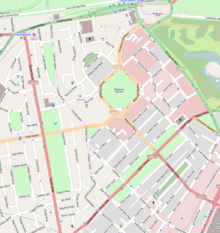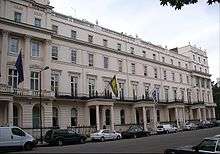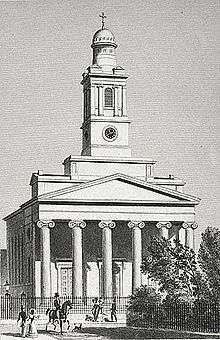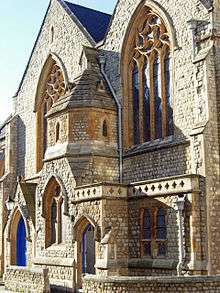Belgravia
Coordinates: 51°29′53″N 0°09′16″W / 51.49795°N 0.15453°W
Belgravia (/bɛlˈɡreɪvɪə/[1]) is a district in West London[2] in the City of Westminster and the Royal Borough of Kensington and Chelsea. It is noted for its very expensive residential properties and is one of the wealthiest districts in the world. Much of it, known as the Grosvenor Estate, is still owned by a family property company, the Duke of Westminster's Grosvenor Group. The area takes its name from one of the Duke's subsidiary titles, Viscount Belgrave. Owing to the Leasehold Reform Act 1967, the estate has been forced to sell many freeholds to its erstwhile tenants.
The district lies mostly to the south-west of Buckingham Palace, and is bounded notionally by Knightsbridge (the road) to the north, Grosvenor Place and Buckingham Palace Road to the east, Pimlico Road to the south,[3] and Sloane Street to the west.
History
The area takes its name from one of the Duke of Westminster's subsidiary titles, Viscount Belgrave. The village of Belgrave, Cheshire is two miles (3 km) from the Grosvenor family's main country seat of Eaton Hall.
Most of the area was originally owned by Richard Grosvenor, 2nd Marquess of Westminster, who had it developed from the 1820s. Thomas Cubitt was the main contractor. Belgravia is characterised by grand terraces of white stucco houses, and is focused on Belgrave Square and Eaton Square. It was one of London's most fashionable residential districts from its beginnings. Fashion design houses that have their retail flagship stores and studios within the area include Philip Treacy, Donna Ida, Jenny Packham and HEMYCA. On the southern edge of Belgravia is Pimlico Road, renowned for its quirky antique shops and high-end furniture and interiors showrooms housing established brands such as Arthur Brett. It is a relatively quiet district in the heart of London, contrasting with neighbouring districts, which have far more busy shops, large modern office buildings, hotels and entertainment venues. Many embassies are located in the area, especially in Belgrave Square.
After the Second World War, some of the largest houses ceased to be used as residences, or townhouses for the country gentry and aristocracy, but the new uses were restricted to certain categories, including embassies, charity headquarters and professional institutions. In the early 21st century, some of these houses are being reconverted to residential use, because offices in old houses are no longer as desirable as they were in the post-war decades, while the number of super-rich in London is at a high level not seen since at least 1939. The average house price in Belgravia, as of March 2010, is £6.6 million,[4] although many houses in Belgravia are among the most expensive anywhere in the world, costing up to £100 million, £4,671 per square foot.[5]
As of 2013, many residential properties in Belgravia were owned by wealthy foreigners who have other luxury residences worldwide in exclusive locations or in their countries of origin; thus many Belgravia properties are unoccupied because their owners were at other properties. This phenomenon has diminished social relations in the neighbourhood.[6]
Squares and streets
Belgrave Square


Belgrave Square, one of the grandest and largest 19th century squares, is the centrepiece of Belgravia. It was laid out by the property contractor Thomas Cubitt for the 2nd Earl Grosvenor, later to be the 1st Marquess of Westminster, in the 1820s. Most of the houses were occupied by 1840.
The original scheme consisted of four terraces, each made up of eleven grand white stuccoed houses, apart from the south-east terrace, which had twelve; detached mansions were in three of the corners and there was a private central garden. The numbering is anti-clockwise from the north: NW terrace Nos. 1 to 11; west corner mansion No. 12; SW terrace 13–23; south corner mansion No. 24; SE terrace Nos. 25–36; east corner mansion No. 37; NE terrace Nos. 38–48. There is also a slightly later detached house at the northern corner, No. 49, which was built in by Cubitt for Sidney Herbert in 1851. The terraces were designed by George Basevi and are possibly the grandest houses ever built in London on a speculative basis. The largest of the corner mansions, Seaford House in the east corner, was designed by Philip Hardwick, and the one in the west corner was designed by Robert Smirke. The square contains statues of Christopher Columbus, Simón Bolívar, José de San Martín, Prince Henry the Navigator, the 1st Marquess of Westminster, a bust of George Basevi and a sculpture entitled Homage to Leonardo, the Vitruvian Man, by Italian sculptor Enzo Plazzotta.[7]
Eaton Square

Eaton Square is one of three garden squares built by the Grosvenor family, and is named after the historic Cheshire manor of Eaton, on which is situated the country house of Eaton Hall, the Grosvenor family's principal seat. Eaton Square is larger but less grand than the central feature of the district, Belgrave Square, and both are larger and grander than Chester Square. The first block was laid out by Thomas Cubitt in 1827.
The houses in Eaton Square are large, predominantly three bay wide buildings, joined in regular terraces in a classical style, with four or five main storeys, plus attic and basement and a mews house behind. The square is one of London's largest and is divided into six compartments by the upper end of Kings Road (northeast of Sloane Square), a main road, now busy with traffic, that occupies its long axis, and two smaller cross streets. Most of the houses are faced with white stucco, but some are faced with brick.
Before the Second World War, Eaton Square was a securely upper-class address, but not of the grandeur of London's very grandest addresses in Mayfair and Belgravia: Belgrave Square, Grosvenor Square, St James's Square or Park Lane. However, after the Second World War, when those places were converted to mainly commercial and institutional use, Eaton Square remained almost wholly residential and rose to the front rank of fashionable addresses. For some years in the 1950s No. 85-87 was used as a London County Council hostel for girls, and accommodated around 150 girls from all corners of the globe. Some of the houses remain undivided, but much of the square has been converted into flats and maisonettes by the Grosvenor Estate. These are often lateral conversions, that is they cut across more than one of the original houses, and they usually cost several million pounds. The exterior appearance of the square remains as it was when it was built, with no intrusive modern buildings. Most, but not all, of the freeholds still belong to the Grosvenor Group, and the present Duke of Westminster has his own London home in the square – an illustration of the migrations of the London upper class already mentioned, as up until the 1920s his predecessors lived, when in London, at Grosvenor House a grand detached townhouse, now demolished, and now the site of the Grosvenor House Hotel in Park Lane.
At the east end of the square is St Peter's Church, a large Church of England building, in a classical style, which features a six-columned Ionic portico and a clock tower. It was designed by Henry Hakewill and built between 1824 and 1827 during the first development of Eaton Square.
Upper Belgrave Street
Upper Belgrave Street is a wide one-way residential street graced with a series of very grand and imposing white stuccoed buildings. It stretches from the south east corner of Belgrave Square to the north east corner of Eaton Square. Particularly imposing are Nos 6, 7 and 8. They are very attractive with unrivalled views down the length of Eaton Place.
Upper Belgrave Street is an exclusive and highly desired address, home to some of the most expensive properties in the world. It has some very large houses, as large as those in Eaton Square itself. Most of the houses have now been divided into flats and achieve sale prices as high as £3,500 per square foot.
Many of the buildings were constructed by Thomas Cubitt in the 1820s and 1830s. No. 13 was built for an illegitimate child of King William IV.
Alfred, Lord Tennyson (1809–1892) lived at No 9 in 1880–1. Walter Bagehot (1826–1877), a writer, banker and economist, lived at No 12 at some point.
No 36 at the corner of Belgrave Square and Upper Belgrave Street is used as the residence for the Belgian ambassador.
Chester Square

Chester Square is a smaller, residential garden square, the latest of the three garden squares built by the Grosvenor family. Chester Square is named after the city of Chester, near to which is Eaton Hall, the ancestral home of the Grosvenor family. Members of the family also represented Chester in Parliament as MP's[8] The garden, just under 1.5 acres (6,100 m2) in size, is planted with shrubs and herbaceous borders. It was refurbished in 1997, to the layout that appears in the Ordnance Survey map of 1867. Past residents include the poet Matthew Arnold (1822–88) at No. 2, Mary Shelley (1797–1851) at No. 24, John Liddell (1794–1868) at No. 72, Margaret Thatcher (1925–2013) at No. 73, and Queen Wilhelmina of the Netherlands (1880–1962) resided at No. 77 from 1940 until 1945 [9]
Wilton Crescent

Wilton Crescent was created by Thomas Cundy II, the Grosvenor family Estate surveyor, and was drawn up with the original 1821 Wyatt plan for Belgravia.[10] It is named after the 2nd Earl of Wilton, second son of the 1st Marquess of Westminster. The street was built in 1825 by William Howard Seth-Smith.
In the 19th and 20th centuries, it was home to many prominent British politicians, ambassadors and civil servants. Louis Mountbatten, 1st Earl Mountbatten of Burma (1900–1979) lived at 2 Wilton Crescent for many years. Today, there is a blue plaque on the house marking it. Like much of Belgravia, Wilton Crescent is characterised by grand terraces with lavish white houses which are built in a crescent shape, many of them with stuccoed balconies, particularly on the southern part of the crescent. The houses to the north of the crescent are stone clad, and five stories high, and were refaced between 1908 and 1912. Most of the houses had originally been built in the stucco style, but such houses became stone clad during this renovation period. Other houses today have black iron balconies.
Wilton Crescent lies east of Lowndes Square and Lowndes Street, to the northwest of Belgrave Square. It is accessed via Wilton Place which connects it to the main road in Knightsbridge. It is adjacent to Grosvenor Crescent to the east, which contains the Indonesian Embassy. Further to the east lies Buckingham Palace. The play Major Barbara is partly set at Lady Britomart's house in Wilton Crescent. In 2007, Wilton Garden, in the middle of the crescent, was awarded a bronze medal by the London Gardens Society.
Lowndes Square

Lowndes Square, like much of Belgravia, is characterised by grand terraces with white stucco houses. To the east lies Wilton Crescent and Belgrave Square. The square runs parallel with Sloane Street to the east, east of the Harvey Nichols department-store and Knightsbridge tube station. It is home to some of the most expensive properties in the world. Russian businessman Roman Abramovich bought two stucco houses in Lowndes Square in 2008. The merged houses, with a total of eight bedrooms, are expected to be worth £150 million, which exceeds the value of the previous most expensive house in London.[11]
George Basevi designed many of the houses in the square. Mick Jagger and James Fox once filmed in Leonard Plugge's house in Lowndes Square. The square was used as a setting in the Edward Frederic Benson novel The Countess of Lowndes Square.[12]
Education
Transport
Nearest stations
The nearest London Underground stations are Hyde Park Corner, Knightsbridge and Sloane Square. Victoria station, a major National Rail, tube and coach interchange, is to the east of the district. Regular bus services run to all areas of Central London from Grosvenor Place.[13]
Belgravia in literature and popular culture
The novels of Anthony Trollope (1815–1882): The Way We Live Now, Phineas Finn, Phineas Redux, The Prime Minister, and The Duke's Children all give accurate descriptions of 19th-century Belgravia.
In Brideshead Revisited, a novel by Evelyn Waugh, Belgravia's Pont Street is eponymous with the idiosyncrasies of the British upper classes. Julia, one of the main protagonists, tells her friends, "It was Pont Street to wear a signet ring and to give chocolates at the theatre; it was Pont Street to say, 'Can I forage for you?' at a dance."
The Queer Feet, a short-story from the The Innocence of Father Brown collection by G. K. Chesterton, is located in the extremely posh fictional hotel Vernon. Author developed a lot of the story on the extreme closeness of the Belgrave environment.
In Love in a Cold Climate, Nancy Mitford's magnum opus, the heroine's aunt, who is raising her to mix in the best society, is said to "keep her nose firmly to Pont Street".
Flunkeyania Or Belgravian Morals, written under the pseudonym "Chawles", was one of the novels serialised in The Pearl, an allegedly pornographic Victorian magazine.[14]
In the popular British television series Upstairs, Downstairs (1971–1975), the scene is set in the household of Richard Bellamy (later 1st Viscount Bellamy of Haversham) at 165 Eaton Place, Belgravia (65 Eaton Place was used for exterior shots, a "1" was painted in front of the house number).[15] It depicts the lives of the Bellamys and their staff of domestic servants in the years 1903–1930, as they experience the tumultuous events of the Edwardian era, World War I and the postwar 1920s, culminating with the stock market crash of 1929, which ends the world they had known. In 2010, filming began on a mini-series intended to pick up the story of one of the main characters, Rose Buck, in 1936, as she returns to 165 Eaton Place to serve the Holland Family as the housekeeper.
In Downton Abbey Lady Rosamund Painswick, sister of Lord Grantham, lives in Belgrave Square. Also the lover of Lady Rose MacClare is said to live in Warwick Square, which Lady Edith Crawley describes as "Belgravia without the bustle".
In the first episode of the television programme Sherlock (Series 2), the modern-day Holmes stars in "A Scandal in Belgravia", loosely based on the Arthur Conan Doyle short story "A Scandal in Bohemia".[16]
In the Woody Allen movie Match Point, Chloe Hewett, the daughter of a wealthy businessman tells the lead character, Chris Wilton, a low-rent social climber, that she grew up in Belgravia and that she would be happy to show him all the really good places.
Notable residents

Past residents
Notable residents have included Prime Ministers Stanley Baldwin (1867–1947) and Neville Chamberlain (1869–1940), American philanthropist George Peabody (1795–1869), Polish composer Frédéric Chopin (1810–1849), Austrian composer Wolfgang Amadeus Mozart (1756–1791), actress Dame Edith Evans (1888–1976), actress Vivien Leigh (1913–1967), Beatles' manager Brian Epstein (1934–1967), novelist Ian Fleming (1908–1964), twice President of Colombia Alfonso Lopez Pumarejo (1886–1959), Irish film director Brian Desmond Hurst (1930s–1986), actors Sir Sean Connery and Sir Roger Moore,[3] Frankenstein author Mary Shelley (1797–1851), the poet Alfred, Lord Tennyson (1809–1892), Lieutenant Colonel Philip Edward Hardwick (1875–1919) who was the son of the architect Philip Charles Hardwick, anatomist Henry Gray, author of Gray's Anatomy and in her retirement, former Prime Minister, The Rt. Hon. Lady Thatcher, who lived in Chester Square.
It is also the birthplace of Lord Randolph Churchill (father of Sir Winston Churchill) and actor Sir Christopher Lee. The missing Lord Lucan lived at 46 Lower Belgrave Street, Belgravia.
References
- ↑ "Belgravia". Collins Dictionary. n.d. Retrieved 24 September 2014.
- ↑ "London's Places" (PDF). The London Plan. Greater London Authority. 2011. p. 46. Retrieved 27 May 2014.
- 1 2 "Belgravia – "The rich man's Pimlico"". City West Homes Residential. Retrieved 12 September 2010.
- ↑ "Belgravia square tops expensive homes list". BBC News. 8 March 2010. Retrieved September 2010. Check date values in:
|access-date=(help) - ↑ "Record £100million price-tag for London 'terrace' house". Daily Mail. 14 April 2010. Retrieved 12 September 2010.
- ↑ Sarah Lyall (1 April 2013). "A Slice of London So Exclusive Even the Owners Are Visitors". The New York Times. Retrieved 2 April 2013.
- ↑ Bob Speel. "Belgrave Square". Archived from the original on 8 August 2008. Retrieved 3 December 2009.
- ↑ Walford, Edward (1878). 'The western suburbs: Belgravia', Old and New London. pp. 1–14. Retrieved 3 December 2009.
- ↑ Steves, Rick. (2012). Rick Steves' England 2013. Avalon Travel Publishing. p. 168. ISBN 1612383890.
- ↑ "Opensquares.org". Opensquares.org. Retrieved 21 August 2014.
- ↑ "Revealed: Roman Abramovich's £150m palace – the most expensive house in Britain". Daily Mail. 27 April 2008. Archived from the original on 3 December 2009. Retrieved 20 November 2009.
- ↑ "The Countess of Lowndes square, and the stories : Benson, E. F. (Edward Frederic), 1867-1940 : Free Download & Streaming : Internet Archive". Archive.org. Retrieved 21 August 2014.
- ↑ Transport to and from Belgravia tfl.gov.uk
- ↑ Chawles, [pseud.]. "Biblio book sales". Biblio.com. Retrieved 21 August 2014.
- ↑ "Upstairs, Downstairs The house 1". Retrieved April 15, 2016.
- ↑ Crompton, Sarah (1 January 2012). "The timeless appeal of Holmes's sexy logic". The Daily Telegraph. Retrieved 5 January 2012.
External links
| Wikimedia Commons has media related to Belgravia. |
- Map of Belgravia and surrounding areas
- The Belgravia Society - Largest local civic amenity body



